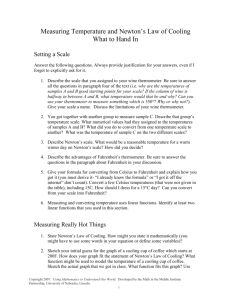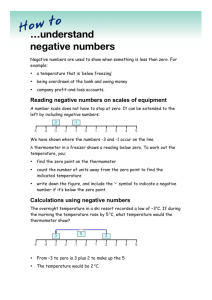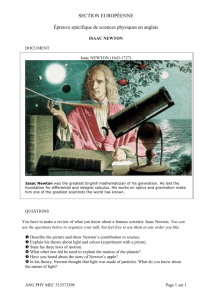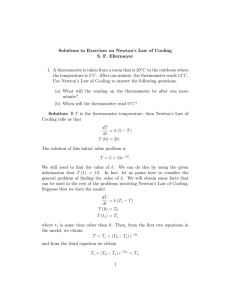Project I - University of Nebraska–Lincoln
advertisement
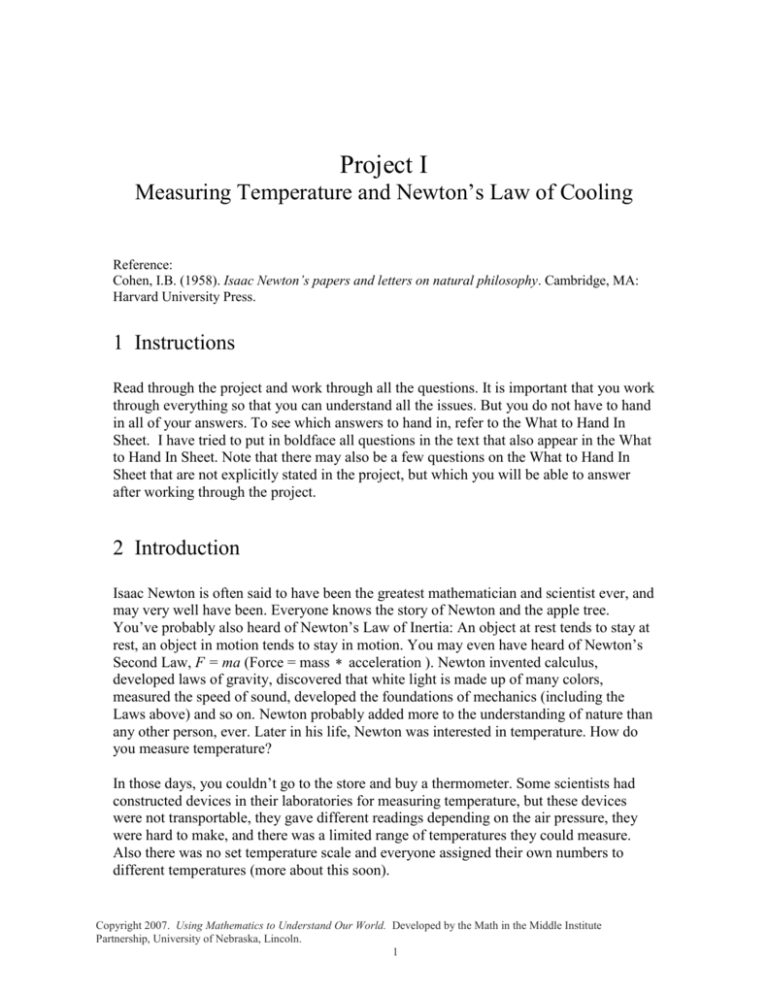
Project I Measuring Temperature and Newton’s Law of Cooling Reference: Cohen, I.B. (1958). Isaac Newton’s papers and letters on natural philosophy. Cambridge, MA: Harvard University Press. 1 Instructions Read through the project and work through all the questions. It is important that you work through everything so that you can understand all the issues. But you do not have to hand in all of your answers. To see which answers to hand in, refer to the What to Hand In Sheet. I have tried to put in boldface all questions in the text that also appear in the What to Hand In Sheet. Note that there may also be a few questions on the What to Hand In Sheet that are not explicitly stated in the project, but which you will be able to answer after working through the project. 2 Introduction Isaac Newton is often said to have been the greatest mathematician and scientist ever, and may very well have been. Everyone knows the story of Newton and the apple tree. You’ve probably also heard of Newton’s Law of Inertia: An object at rest tends to stay at rest, an object in motion tends to stay in motion. You may even have heard of Newton’s Second Law, F = ma (Force = mass acceleration ). Newton invented calculus, developed laws of gravity, discovered that white light is made up of many colors, measured the speed of sound, developed the foundations of mechanics (including the Laws above) and so on. Newton probably added more to the understanding of nature than any other person, ever. Later in his life, Newton was interested in temperature. How do you measure temperature? In those days, you couldn’t go to the store and buy a thermometer. Some scientists had constructed devices in their laboratories for measuring temperature, but these devices were not transportable, they gave different readings depending on the air pressure, they were hard to make, and there was a limited range of temperatures they could measure. Also there was no set temperature scale and everyone assigned their own numbers to different temperatures (more about this soon). Copyright 2007. Using Mathematics to Understand Our World. Developed by the Math in the Middle Institute Partnership, University of Nebraska, Lincoln. 1 Early thermometers were constructed in a manner similar to the following (though different people had different variations). A bulb of glass was filled with a liquid, often wine. Out of the bulb came a thin glass tube. As the liquid was heated, it expanded and rose up the tube. Its height could be measured and assigned a numerical value. Wine was used because it had a color and so its height was easy to read. Also it has a low freezing point and relatively high boiling point (why do you think this is important?). Though this sort of thermometer is not dissimilar to the one used today, there were many problems with it. First, the tube was open and so if the air pressure changed that would also affect the height of the column of wine- a higher air pressure would tend to push down more on the column of wine and make it shorter. At that time, air pressure had not yet been discovered. Second, the thermometer could not measure temperatures lower than the freezing point of wine or higher than the boiling point. Third, it was very difficult for even the best glass blowers to make glass tubes. Newton, in his work on temperature, was interested in two things: developing a good temperature scale and developing a method to measure very hot things, hotter than the boiling point of wine. In this project, we will explore some of Newton’s ideas. We will get to use linear and exponential functions! 3 Setting a Scale We will begin by constructing a simple thermometer similar to ones created by Newton and his predecessors. In building such a thermometer, we will have to ask a question that Newton and other early scientists faced, but about which we seldom think in modern times. That question is: how do we assign numerical values to temperature? It is simple to construct a crude thermometer. Fill a small glass bottle with wine, insert a thin glass tube through a rubber stopper (the thinner the better- why?), and put the stopper in the top of the bottle. For an even cruder version that you might be able to do with your kids, you can use a soda bottle, colored water, clay and a clear drinking straw. Now that you have your thermometer, place it in sample A. The column of wine should decrease. Mark on your thermometer the height of the column once your thermometer has reached the same temperature as that of sample A. This is the “temperature” of sample A. Now move your thermometer (carefully) to sample B. Mark the temperature of sample B on your thermometer. Now that you have two temperature readings, you are ready to set a scale. Note that you will only use your numbers for the temperatures of sample A and sample B to set the scale. Don’t use room temperature. (Why do you only need two temperatures to set the scale? Why is it good if these to temperatures are relatively far apart on your glass tube) Assign a number to the temperature of sample A and a number to the temperature of sample B. Give your scale a name, like degrees Wendy (this is just what Fahrenheit and Celsius did except they used their last names). Copyright 2007. Using Mathematics to Understand Our World. Developed by the Math in the Middle Institute Partnership, University of Nebraska, Lincoln. 2 Suppose you measured something which caused the column of wine to have a height exactly between your first two readings? What numerical value would you assign to the temperature? Why? Can you use your thermometer to measure something which is 350F? Why or why not? Get together with another group. Use one of your thermometers to measure the temperature of sample C. Write down your answer. If you had used the other group’s thermometer, what numerical temperature value would you have gotten? Don’t actually measure the temperature of sample C with the other thermometer until you have made your prediction (using mathematics!), but then you can measure it if you want to confirm your prediction (though beware that the temperature of the sample may have gotten closer to room temperature while you were doing your computations). In Newton’s day, this question of scale had not yet been resolved. The few people who were measuring the temperature of things each had their own scale. Often they would give temperatures based on the melting points of known metals or substances such as “the temperature of this sample is twice the melting point of tin”. Newton himself assigned 0 to be the temperature at which water freezes and 33 to be the temperature at which water boils. His scale was known as the Newton Scale and was used for a little while, though it was not the most commonly used scale of his time. What would be a reasonable temperature for a warm winter day on the Newton scale? Copyright 2007. Using Mathematics to Understand Our World. Developed by the Math in the Middle Institute Partnership, University of Nebraska, Lincoln. 3 Measuring temperature became much more standardized with Gabriel Fahrenheit’s invention of the mercury thermometer. His thermometer had several advantages over previous ones. Mercury experiences a large expansion for a fairly small change in temperature, so it is easier to detect accurately small changes in temperature (such as those experienced by the human body during illness). Also mercury expansion is very linear. That is if the temperature increases from 0 to 10F the volume of the mercury will increase the same amount that it would if the temperature increased from 100 to 110F (why is this important)? This is not true for wine, which expands somewhat less when the temperature increases from 0 to 10 than it does when the temperature increases from 100 to 110. Another advantage of mercury is that its boiling point is 356.7C (why is this important?). Its freezing point however is -39C which is quite a bit higher than that of alcohol (so which sort of thermometer would be better in the Arctic?). Fahrenheit’s thermometer was enclosed and so air pressure would not affect temperature readings. He set his scale in the following way: “Placing the thermometer in a mixture of sal ammoniac (i.e. sea salt), ice, and water a point on the scale will be found which is denoted as zero. A second point is obtained if the same mixture is used without salt. Denote this position as 30. A third point, designated as 96, is obtained if the thermometer is placed in the mouth so as to acquire the heat of a healthy man.” (D. G. Fahrenheit,Phil. Trans. (London) 33, 78, 1724) So for Fahrenheit, 0 was the freezing point of salt water, 30 was the freezing point of water and 96 was the temperature of a healthy person. This scale was later changed a little to the current one, where 32 is the freezing point of water and 98.6 the temperature of a healthy human. Using this scale, the boiling point of water is 212. A few years later Anders Celsius devised a scale where 0 was the freezing point of water and 100 was the boiling point of water. Both of these scales are used today. Below is a table showing conversions from Fahrenheit to Celsius. Fahrenheit 32 212 50 80 Celsius 0 100 10 26.66 Use the tables to come up with a conversion formula to convert Celsius to Fahrenheit. How many table entries do you need to do this?. Copyright 2007. Using Mathematics to Understand Our World. Developed by the Math in the Middle Institute Partnership, University of Nebraska, Lincoln. 4 A conversion formula is very important to have. I use it all the time when I visit my husband’s family in England. If I’m in England and the weather forecast is for a high of 15C, how should I dress? What is the temperature of sample C in degrees Fahrenheit? What information do you need to know in order to answer this question? 4 Measuring Really Hot Things Newton’s thermometer used linseed oil which has a boiling point of 200F. He wondered how he could measure the temperature of hotter things and he came up with the following ingenious idea. He reasoned that really hot things decrease their temperature a lot more at first than do things that are just a bit warmer than room temperature. For example a 200F cup of coffee in a 40F room might decrease 20F in the first ten minutes, whereas a 50F cup of coffee might decrease only a degree. A more mathematical way of saying this is that the rate of change of the temperature of an object is proportional to the difference between the object’s temperature and the room temperature. The temperature of an object decreases quickly when it is a lot hotter than its surroundings and slowly when it is only a little hotter than its surroundings. Similarly the temperature of a cold object increases quickly when it is a lot colder than its surroundings and increases slowly when it is only a little colder. We all know that if you put a beer in the freezer it cools down to 50F a lot more quickly than if you put it in the fridge, even though both compartments are below 50F. This idea that the rate of change of temperature is proportional to the temperature difference is known as Newton’s Law of Cooling (how would you write it mathematically?). Let’s see how Newton used this idea to measure the temperature of really hot things. Newton wanted to measure the melting temperature of metals such as tin, lead and Copyright 2007. Using Mathematics to Understand Our World. Developed by the Math in the Middle Institute Partnership, University of Nebraska, Lincoln. 5 bitumen. He heated an iron bar until it was red hot, as hot as he could make it. Then he put a bit of each metal on the bar. The metal drops melted, but as the bar cooled each metal drop re-solidified just as the temperature of the bar decreased below the metal’s melting point. He measured the amount of time it took for each bit of metal to re-solidify and recorded that time. He let the bar cool until it was 200F, cool enough to measure using his linseed oil thermometer. He also wrote down the amount of time it took the bar to cool to 200F. Using that time, he could work backwards and figure out what temperature the iron bar had been originally. Knowing the original temperature of the bar and the time it took for each drop of metal to solidify, he could work forwards again and find the temperature at which each drop of metal solidified; i.e. the melting point of that particular metal. In the end, his results, especially for the higher temperatures, were pretty inaccurate, but it was a clever idea and it was the first time anyone had gotten any qualitative results about the temperatures of hot things. More importantly it was the first time that Newton’s Law of Cooling was used and this is a law that scientists and engineers and others use all the time today. There are many things about temperature that Newton didn’t know to take into account and so Newton’s Law of Cooling is not exactly correct in every situation, but often in fact it is quite accurate. Let’s think about a cup of coffee which, say, starts out at 180F, sitting in a room that is 70F. If the temperature of the coffee follows Newton’s Law, sketch a graph of what its temperature might look like. Can you think of a function whose graph also looks like this? Write down a function that would work. Is there only one? In class, your instructor will measure the temperature of a cup of coffee at regular intervals and record the data. Can you find a function that fits this data? If a cup of coffee starts out at 180F, when will it be cool enough to drink, say down to 120F? Newton’s Law provides a pretty good description (though not perfect) of the temperature of a hot cup of coffee in a cooler room. Copyright 2007. Using Mathematics to Understand Our World. Developed by the Math in the Middle Institute Partnership, University of Nebraska, Lincoln. 6 Give a formula for the temperature of a hot object in a cooler room. Use T(t) for the temperature of the object, Ta for the temperature of the room (a stands for “ambient” which means the “surrounding stuff’)’, and r for the cooling rate. The cooling rate is something that you can find out by taking a few measurements. Use this formula to solve the following problem: a cup of 170F hot chocolate is put in a 70F room. After 5 minutes the hot chocolate cools to 150. When will the hot chocolate be 110F (so you can drink it!)? This brings us to the end of the workshop (hopefully!). The rest of the project will be done back home. You can also use Newton’s Law of Cooling for things that are warming up. A cold object in a warm room warms up proportionally to the difference in temperature of the object and the room. What would the graph of the temperature of a cold object in a warm room look like? What function could you use to model this? How is this similar to or different from the formula for cooling objects? Why? Use your model to solve the following problem. My daughter and I like to make pound cake together, but one secret of pound cake is that the ingredients must be at room temperature when you prepare the batter. Our recipe calls for a cup of milk. I take the milk out of our 40F fridge and measure a cup and leave it in our 75F kitchen. After 10 minutes, I measure the temperature of the milk and discover that it is up to 45F. How long will I have to wait until it is warm enough to use, say 65F? If I want to start baking by 6:30pm so that my daughter will have time to eat some cake before bed, at what time should I take the milk out from the fridge? Copyright 2007. Using Mathematics to Understand Our World. Developed by the Math in the Middle Institute Partnership, University of Nebraska, Lincoln. 7 4.1 Pound Cake Complications The pound cake is baked in a 400F oven for an hour. Before cutting the cake, you must let it “completely cool”. That means it must be “cool” even on the inside. Suppose I use a cooking thermometer to take the temperature inside the cake when it comes out of the oven and 15 minutes later. Using those measurements, I could use Newton’s Law to figure out when the cake will be cool (once I assign a temperature value to “cool”). How accurate do you think my prediction will be? If you bake a cake at home you could make a graph of the temperature of the cake and see how well it satisfies Newton’s Law . A big thick cake is the most interesting (I’ll post an easy and delicious recipe for pound cake on the class heating/cooling discussion board). Are there factors that you think might slow down or speed up the cooling process for the cake? Are there factors you think might make cake cooling any different from Newton’s Law? Can you think of any real-life situations where it might be important for scientists to be able to predict how long it takes for an object to heat up or cool off? Note that I used the word it predict rather than know. Even just one example is enough. Post your thoughts to your group’s heating/cooling discussion board. 5 Who Killed John Boddy? Colonel Mustard walked into the library at the Boddy mansion in search of some light reading. What he found was not light at all. John Boddy, the master of the house, was lying dead in a pool of blood in the middle of the library floor. Lying next to him was a hefty lead pipe. Being trained to remain calm and sensible in emergencies, Colonel Mustard calmly, but quickly, walked into the bathroom and found the thermometer in Boddy’s medicine cabinet and took it back to where the body lay. It being difficult to get Copyright 2007. Using Mathematics to Understand Our World. Developed by the Math in the Middle Institute Partnership, University of Nebraska, Lincoln. 8 dead people to keep a thermometer under their tongue, Mustard took a rectal temperature of the body and found it to be 98F. Normal rectal temperature is 99.6F. Mustard recorded the body temperature, the temperature of the room, which was 70F, and the time, which was 5:00pm. Then he waited a half hour and took another temperature reading. This time it was 97.23F. Colonel Mustard thought about the activities of the other of Boddy’s guests that day. Professor Plum, Mister Green and Mrs. Peacock had all left on a birdwatching expedition around 3:00pm. Miss Scarlet had planned to go with them, but came down with a terrible headache and had taken to her bedroom instead. Mrs. White, Boddy’s cook, had spent the afternoon at the market buying fresh vegetables for the evening meal. Colonel Mustard marched himself into Miss Scarlet’s bedroom (something a well-bred gentleman should never do) and announced “I accuse you, Miss Scarlet, of killing Mr. Boddy in the library with a lead-pipe.” What do you think of Colonel Mustard’s accusation? Obviously when a dead body is found it is ideal to be able to pinpoint the time of death. Such evidence can be very helpful in identifying suspects, and every coroner is trained in techniques to identify time-of-death. What sorts of things do you think can influence the cooling rate of a dead body? Post your ideas to your group’s heating/cooling discussion board. Scientific research has been done on the cooling of dead bodies since the middle 1850’s and this work has been used by forensic scientists to devise formulas to compute timesince death based on after-death temperatures. One thing that was discovered was that the body does not begin cooling immediately after death, in fact, in some cases the temperature of the body first increases a little. The period before cooling begins is called the “plateau”. Though this plateau period is not completely understood there are many explanations for it: metabolic processes do not necessarily stop right at death, cessation of Copyright 2007. Using Mathematics to Understand Our World. Developed by the Math in the Middle Institute Partnership, University of Nebraska, Lincoln. 9 circulation means that the body cannot so easily dissipate heat from metabolic processes, body fat insulates the body and maintains its temperature for some time, and so on. Coroner’s do use temperature methods to predict the time since death, but they use other information as well. For example, if it is known what time the victim had lunch, the coroner can examine the stomach contents and see how much digestion has occurred. The coroner can check how much rigor mortis has occurred. The level of potassium in the vitreous humor of the eye can be measured. Potassium diffuses out of the retina and into the vitreous humor after death and many animal studies have been done to measure the rate of diffusion (so that a mathematical model of the potassium can be determined). None of these methods are terribly accurate and coroners use many measurements, including temperature, and experience to estimate the time since death. To learn more you can go to http://www.dundee.ac.uk/forensicmedicine/llb/timedeath.htm In our next project we will learn more about using body temperature to measure time since death and then we will be able to get a better handle on the mystery of who killed John Boddy! Copyright 2007. Using Mathematics to Understand Our World. Developed by the Math in the Middle Institute Partnership, University of Nebraska, Lincoln. 10 Copyright 2007. Using Mathematics to Understand Our World. Developed by the Math in the Middle Institute Partnership, University of Nebraska, Lincoln. 11
